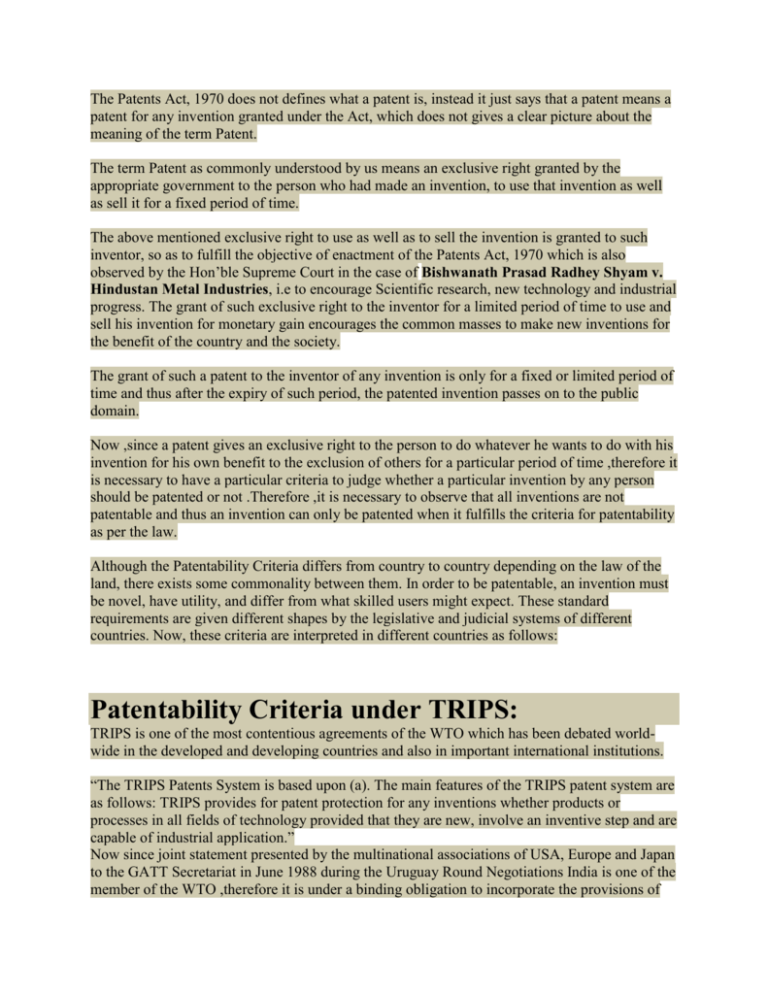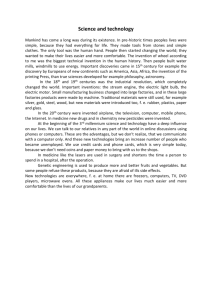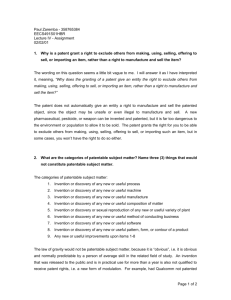comparative perspective of patentability
advertisement

The Patents Act, 1970 does not defines what a patent is, instead it just says that a patent means a patent for any invention granted under the Act, which does not gives a clear picture about the meaning of the term Patent. The term Patent as commonly understood by us means an exclusive right granted by the appropriate government to the person who had made an invention, to use that invention as well as sell it for a fixed period of time. The above mentioned exclusive right to use as well as to sell the invention is granted to such inventor, so as to fulfill the objective of enactment of the Patents Act, 1970 which is also observed by the Hon’ble Supreme Court in the case of Bishwanath Prasad Radhey Shyam v. Hindustan Metal Industries, i.e to encourage Scientific research, new technology and industrial progress. The grant of such exclusive right to the inventor for a limited period of time to use and sell his invention for monetary gain encourages the common masses to make new inventions for the benefit of the country and the society. The grant of such a patent to the inventor of any invention is only for a fixed or limited period of time and thus after the expiry of such period, the patented invention passes on to the public domain. Now ,since a patent gives an exclusive right to the person to do whatever he wants to do with his invention for his own benefit to the exclusion of others for a particular period of time ,therefore it is necessary to have a particular criteria to judge whether a particular invention by any person should be patented or not .Therefore ,it is necessary to observe that all inventions are not patentable and thus an invention can only be patented when it fulfills the criteria for patentability as per the law. Although the Patentability Criteria differs from country to country depending on the law of the land, there exists some commonality between them. In order to be patentable, an invention must be novel, have utility, and differ from what skilled users might expect. These standard requirements are given different shapes by the legislative and judicial systems of different countries. Now, these criteria are interpreted in different countries as follows: Patentability Criteria under TRIPS: TRIPS is one of the most contentious agreements of the WTO which has been debated worldwide in the developed and developing countries and also in important international institutions. “The TRIPS Patents System is based upon (a). The main features of the TRIPS patent system are as follows: TRIPS provides for patent protection for any inventions whether products or processes in all fields of technology provided that they are new, involve an inventive step and are capable of industrial application.” Now since joint statement presented by the multinational associations of USA, Europe and Japan to the GATT Secretariat in June 1988 during the Uruguay Round Negotiations India is one of the member of the WTO ,therefore it is under a binding obligation to incorporate the provisions of TRIPS in their domestic laws and therefore with the enactment of Patents (Amendment) Act 2005, the amending process of Indian Patents Act 1970 to bring it in line with the TRIPS Agreement has been completed by the government by incorporating the following provisions in the Patents Act,1970 Clause (j) in Section 2, which defines patentable invention as "invention means a new product or process involving an inventive step and capable of industrial application". The earlier two amendments were enacted by Parliament during 1999 and 2002. Clause(ja) in section 2 which defines "inventive step" as a feature of an invention that involves technical advance as compared to the existing knowledge or having economic significance or both and that makes the invention not obvious to a person skilled in the art Clause (l) in section 2 which defines "new invention" as any invention or technology which has not been anticipated by publication in any document or used in the country or elsewhere in the world before the date of filing of patent application with complete specification, i.e. the subject matter has not fallen in public domain or that it does not form part of the state of the art. Thus from the above, it is clear that under the Indian Patent Law, an invention in order to be patented should fulfill the following three conditions, these are: 1) Invention must be New Novelty is a fundamental requirement and an undisputed condition of patentability. An invention will not be novel if it has been disclosed in the public through any type of publication anywhere in the world. For example, a lot of hue and cry has been raised in India when the patent was granted to turmeric products in United States on the ground that it is not new and it is already published in Indian Texts and use of Turmeric preparations has been made in India since times immemorial. Further .the Newness of an invention depends upon the state of existing knowledge as well as the similar inventions in that particular field. Prior use of invention before filing an application for patent can also destroy novelty. Oral description of the invention in some seminar/conference can spoil novelty if the patent application is not filed within a stipulated time period, which is six months in India. 2) Useful An invention even though it is new as well as non obvious to a person skilled in the art to which it relates cannot be granted a patent unless and until it is of some use to the Mankind .Therefore, a useless invention though may be new and non obvious will not be granted the status of a patent 3) Non Obvious to the person skilled in the art to which the invention relates to: The Invention by any person in any field of art shall be of such a nature that a person, who is also skilled in the art to which this invention relates, shall not be able to come to that invention unless he is acquiring some special mental skills. Patentability Criteria in the United States: In the United States, in order to meet the litmus test of patentability, an idea must satisfy a threepronged test of novelty, non-obviousness, and utility. Also, the invention must not have been in public use or sale in the US for more than one year prior to date of filing the patent application. The US patent statute states that an invention is deemed obvious, “…if the difference between the subject matter sought to be patented and the prior art are such that the subject matter as a whole would have been obvious to a person having ordinary skill in the art to which the subject matter pertains.” The “utility” requirement is probably the easiest criteria to meet as virtually any usefulness is considered to meet the “utility” requirement. The Patent Law in United States were very liberal in the beginning like the Indian Patent Law on the patentability condition of Non Obviousness ,but now the Patent Law in the United States is tightening up after the coming up of the two landmark cases of KSR vs. Teleflex and Pfizer vs. Apotex. The KSR v. Teleflex case involved the usage of electronic sensor based adjustable gas pedals. Teleflex accused KSR International of using a gas pedal technology claimed in one of Teleflex’s patents. KSR counter argued that Teleflex should not have been granted a patent for that pedal in the first place, as the combination of an electronic sensor and gas pedal technology was obvious based on prior art. The US Supreme Court reversing the decisions of a lower court held that the sensor based gas technology was obvious from the teachings of other patents and invalidated Teleflex’s patent. In his opinion, Justice Anthony Kennedy wrote for the Court, “The results of ordinary innovation are not the subject of exclusive rights under the patent laws. Were it otherwise, patents might stifle rather than promote the progress of useful arts.” Thus, from the above discussion the concept of the patentability criteria for any invention in any field of art is clear as far as it relates to India as well as in the United States. Patentability Criteria in Europe: The European Patent Convention (EPC) puts forth four Criteria of Patentability. An invention is patentable if, (i) it is novel (Article 54 EPC) , (ii) involves an inventive step (Article 56 EPC) , (iii) is capable of industrial application (Article 57 EPC), and (iv) is not excluded by Article 52(2) and (3) EPC. NoveltyNovelty in EPC is slightly stricter than US law. According to EPC the invention must not be found at a previous date in any matter, whether a product, a process, the information have not been made available to the public whether in European country or anywhere in the world. InventivenessAn invention must involve an inventive step in order to be patented. According to the law, a person with ordinary brain and skill in the art should not be able to derive the claims of the invention. This criterion is very similar to the US Criteria of non-obviousness. Industrial applicationAn invention must have an industrial application in order to be patented. Section 4 states that an invention shall be taken to be capable of industrial application if it can be made or used in any kind of industry including agriculture. This criterion is similar to the US Criteria of utility. Non exclusion by article 52(2) and (3) of EPC These articles exclude many items from the list of patentable items. Some of them as below: An invention is excluded if it has no technical character. The technical considerations may lie in the underlying problem solved or in the technical effects achieved. - A method claim that does not mention any implementing technology will be rejected. - A discovery, scientific theory or mathematical method is not patentable. - An invention which is offensive, immoral or anti-social is not patentable. Criteria in Japan Art. 2 of the Japanese Patent Act says, “Invention” in this Law means the highly advanced creation of technical ideas by which a law of nature is utilized. Article 29 talks about as follows. Section (i) Any person who has made an invention which is industrially applicable may obtain a patent therefore, except in the case of the following inventions: (ii) inventions which were publicly known in Japan or elsewhere prior to the filing of the patent application; (iii) Inventions which were publicly worked in Japan or elsewhere prior to the filing of the patent application; (iv) Inventions which were described in a distributed publication or made available to the public through electric telecommunication lines in Japan or elsewhere prior to the filing of the patent application. Section (2) says that Where an invention could easily have been made, prior to the filing of the patent application, by a person with ordinary skill in the art to which the invention pertains, on the basis of an invention or inventions referred to in any of the paragraphs of Subsection (1), a patent shall not be granted for such an Invention notwithstanding Subsection (1) Exceptions: Now as far as the exceptions to the patentability of an invention is concerned, the amendment of 2005 in the Indian Patents Act,1970 has provided for various kinds of inventions which inspite of being New ,Non – obvious as well as Useful cannot be patented under the Patents Act,1970 . These inventions would be: 1) Those invention which are injurious to public health or violate public morality or public interest 2) New method of agriculture or horticulture is non –patentable invention in order to have a more widespread benefit of such invention rather than concentrating the commercial gain of such invention in the hands of the inventor alone. 3) A process of treatment of Human Beings .animals or plants cannot be patented. Conclusion: After all the discussion above, as far as India is concerned ,it can authoritatively be said that though it is having a quite sensible Patentability Criteria for patenting the inventions in any field of art, which are New ,Useful as well as Non –Obvious (to the person skilled in that Field of Art to which the Invention relates) , but at the same time it shall also be remembered that the Patent Laws in India which were originally enacted in 1970, needs to be further amended as far as the field of Medicines is concerned because the Patent system in India does not affect the rich and the elite class of people but it does affect the availability and affordability of medicines for the poor people who in the developing country like India are caught in a vicious circle wherein the Poor health leads to poverty, and poverty in its turn breeds poor health. Therefore ,the Patent Act, 1970 in India dealing with the Patentability criteria should be modified to such an extent so as to make them as stringent as possible while granting patents to inventions in field of medicines, so that the concern for the poor and the critical health situation in India should be taken care of .For example ,an invention which can cure a deadly disease like cancer shall not be easily allowed to be patented under the Patent Laws in India as granting of Patent to such an invention will not serve the general purpose of curing Poor people who constitutes majority of our population, as the inventor of such patented medicine will be having the exclusive rights to make and sell that medicines at a discretionary price which can only be afforded by the rich and elite class of people. It is important to note that the Patents Act, 1970 was amended in 1999, wherein only Product Patent can be granted to the inventions in field of Medicines and compounds, to the exclusion of Process Patent and thus further cementing the above views mentioned therein. Thus, the degree of flexibility in the Patentability Criteria of Novelty, Usefulness and NonObviousness while granting or refusing to grant a patent to an invention shall differ from invention to invention and the patent office has to take into consideration all the Benefits and losses to the Inventor as well as the General Community while granting or refusing to grant a patent to an invention in any field of Art to which it relates. Other References: (1) Law relating to Patents, Trademarks ,Copyright, Designs and Geographical indications – By Mr. B.L.Wadhera, Universal Law Publishing Co. Pvt. Ltd. Third Edition (2) Patent Law – P. Narayanan, Eastern Book Publishing House, Third Edition
![Introduction [max 1 pg]](http://s3.studylib.net/store/data/007168054_1-d63441680c3a2b0b41ae7f89ed2aefb8-300x300.png)






